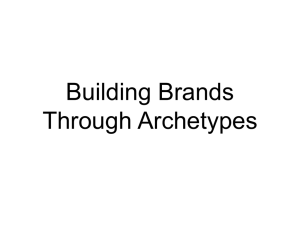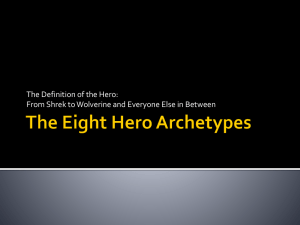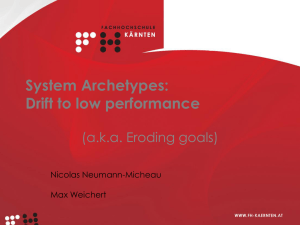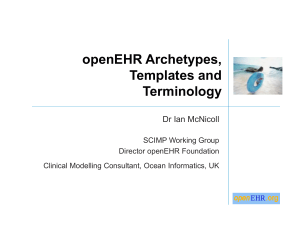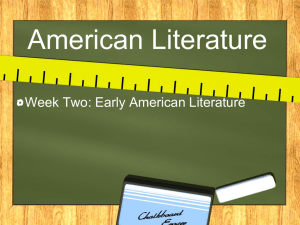Introduction to the NHS Scotland Medication and Drug
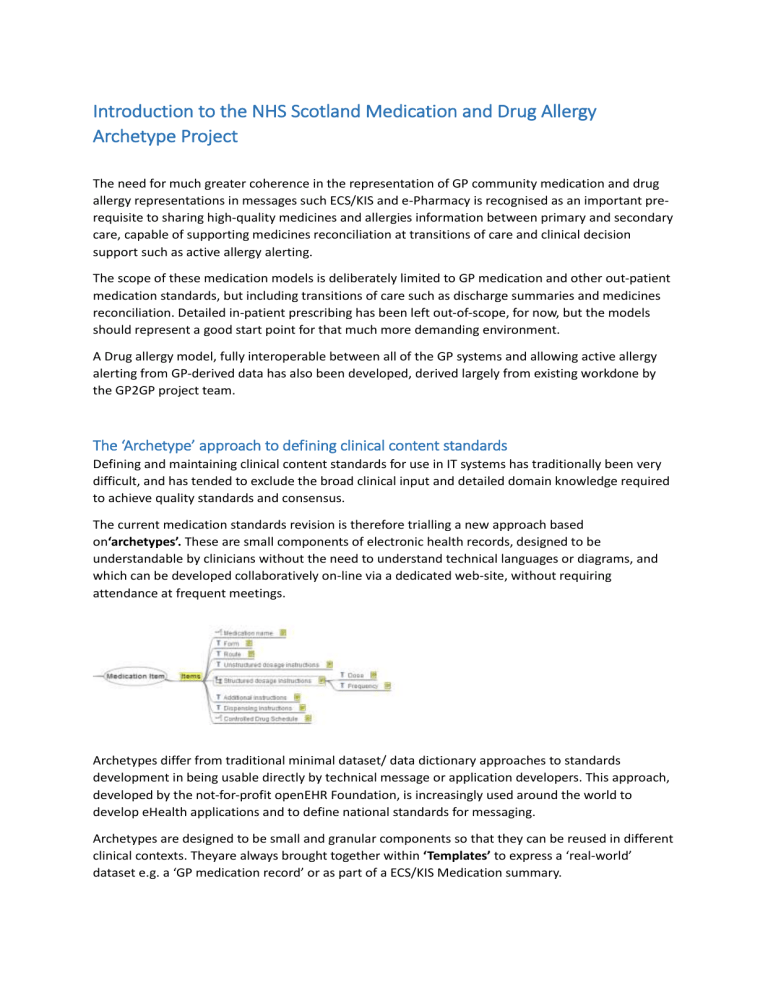
Introduction to the NHS Scotland Medication and Drug Allergy
Archetype Project
The need for much greater coherence in the representation of GP community medication and drug allergy representations in messages such ECS/KIS and e-Pharmacy is recognised as an important prerequisite to sharing high-quality medicines and allergies information between primary and secondary care, capable of supporting medicines reconciliation at transitions of care and clinical decision support such as active allergy alerting.
The scope of these medication models is deliberately limited to GP medication and other out-patient medication standards, but including transitions of care such as discharge summaries and medicines reconciliation. Detailed in-patient prescribing has been left out-of-scope, for now, but the models should represent a good start point for that much more demanding environment.
A Drug allergy model, fully interoperable between all of the GP systems and allowing active allergy alerting from GP-derived data has also been developed, derived largely from existing workdone by the GP2GP project team.
The ‘Archetype’ approach to defining clinical content standards
Defining and maintaining clinical content standards for use in IT systems has traditionally been very difficult, and has tended to exclude the broad clinical input and detailed domain knowledge required to achieve quality standards and consensus.
The current medication standards revision is therefore trialling a new approach based on‘archetypes’. These are small components of electronic health records, designed to be understandable by clinicians without the need to understand technical languages or diagrams, and which can be developed collaboratively on-line via a dedicated web-site, without requiring attendance at frequent meetings.
Archetypes differ from traditional minimal dataset/ data dictionary approaches to standards development in being usable directly by technical message or application developers. This approach, developed by the not-for-profit openEHR Foundation, is increasingly used around the world to develop eHealth applications and to define national standards for messaging.
Archetypes are designed to be small and granular components so that they can be reused in different clinical contexts. Theyare always brought together within ‘Templates’ to express a ‘real-world’ dataset e.g. a ‘GP medication record’ or as part of a ECS/KIS Medication summary.
Four-Nation approach
It is also recognised that whilst each UK nation has a legitimate need to develop e-Health services and technologies suitable to local need and resources, that when applied to clinical content modelling, this places an increasing burden on system developers and hampers cross-border information sharing.
The medication archetypes have been designed to align with current UK models of all 4 nations, previous detailed analysis and research done as part of the English CfH program, and UK standards such as the dm+dMedication terminology.
We have also liaised with the RCP Health Informatics Unit, and the Royal Pharmaceutical Society to ensure that the archetypes are aligned with (and inform) emerging professional standards in this area.
The UK Clinical Knowledge Manager website
The dedicated web-based application that will be used to allow review and comment on the proposed standards is called ‘Clinical Knowledge Manager’ and can be found at: http://clinicalmodels.org.uk
Anyone, interested in viewing the models,or helping with their development and review should register with this website (registration is free).
The medication and allergies archetypes/templateshave been uploaded to the site along with supporting design documentation and some example SCI-XML schema fragments.
Work is ongoing to upload further documentation, examples and training material and formal review of the models should start in the very near future.
Open-source licensing
The CKM application is a proprietary tool developed by Ocean Informatics, but all of the archetypes, templates and associated materials held there are freely and openly available, under a Creative
Commons ‘open-source’ type licence (CC-BY-SA). Some use is made of archetypes developed by the openEHR Foundation, with similar ‘open’ licensing.
Clinical reviews
The CKM tool acts as a repository for the archetypes and templates but also allows registered users to comment or take part in formal reviews of the archetypes, leading to ‘publication’ of the models, at which point they can be used safely by developers. Users will be formally invited to take part in these reviews by email but can always freely decline the invitation.
The reviews are intended to capture as wide as perspective as possible, of the needs of clinical users and system developers. This will help achieve consensus, or at worst, make the limits of information sharing apparent, whether due to the demands of legacy systems or local variation
Explanatory videos of the CKM review process are available via http://www.openehr.org/wiki/display/healthmod/Clinical+Knowledge+Manager+Video+Tutorials
Key medication archetypes and templates
A.
“Medication Item” archetype
This archetype records details of a medication product, dosage and administration instructions, for use within medication recommendation, order, administration and dispensation records.
Remember that this is a sub-component, and many other items such as dates of issue, administration, batch numbers etc. will be carried in other archetypes.
Click here to be taken directly to a view of the Medication itemhttp://clinicalmodels.org.uk/ckm/OKM.html - showarchetypebyID_openEHR-EHR-
EVALUATION.drugallergy.v1
archetype:
Mindmap view
Some clinicians may find an equivalent ‘Mindmap’ view easier to understand
Click here to be taken directly to a Mindmap view of the Medication item http://clinicalmodels.org.uk/ckm/OKM.html - showarchetypebyID_openEHR-EHR-
EVALUATION.drugallergy.v1
archetype:
B.
“Drug Allergy” archetype
This archetype is very closely aligned to the CfH GP2GP Drug allergy archetype and should be used to record allergies, intolerances and adverse reactions to drugs and other medicinal substances. It is designed primarily for use with in a UK primary care context but may be suitable for use within secondary care, particularly where the prime requirement is to record propensity to drug allergy for decision support purposes.
Click here to be taken directly to a view of the Drug Allergy archetype:
Click here to see the Mindmap view of the Drug allergy archetype:
Commenting on the archetypes
Although reviews provide the formal way of getting feedback on the archetype, you can comment at any time via the Discussion button.
“Adopt” an archetype?
If you are interested in helping develop this archetype and have registered on CKM, please press the
‘Adopt Archetype button so that you will be invited to reviews, and notified of any change.
Background documentation
Where possible we will provide as much background documentation as possible. Considerable work has already been done in this area and the archetypes have drawn heavily on this experience. You can see the background documentation click on the Resource centre button.
Click here for Background reference and design documentation on the Medication Item archetype.
Technical documentation
An example SCI-XML schema derived from the medication archetypes can be downloaded at http://clinicalmodels.org.uk/ckm/document?cid=1051.48.8
This is intended only as a very rough first draft but the close relationship between the archetype definitions and eventual expression in the SCI-XML schema should be evident. It should similarly be possible to trace an archetype element to an equivalent entity in an HL7 message or National Data
Services API element.
There are mechanisms which allow XML schema to be directly generated from archetypes, an approach being used in Australia to generate CDA fragments. In this context it is important to note that changes to an archetype are very carefully version-controlled, so that downstream artefacts can be generated safely without disrupting existing systems and messages.
Next Steps
The immediate next steps are to finish uploading archetypes, templates and related documentation, then invite a very broad group of clinical and technical experts to review and comment upon the archetypes, preferably following an introductory workshop where the process and proposals can be explained in more depth.
The review process is thenwholly run via the CKM website, so that further face-to-face meetings are not required. After a few iterations of adjustment in response to review comments, the archetypes will be formally ‘published’ as standards. These can then easily translated into technical formalisms such as SCI-XML. In future it may be possible to do this automatically.
This approach also supports the critical ongoing maintenance of the standards, so that new clinical requirements can be quickly incorporated in a controlled fashion without compromising systems and clinical safety.We look forward to seeing your comments and thoughts in due course.
Ian Thompson
Paul Miller
Libby Morris
Ian McNicoll
SCIMP Working Group
